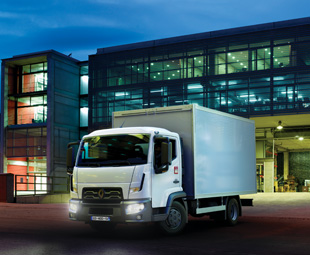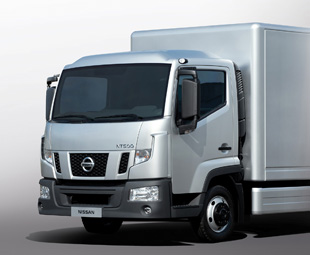Renault reinvents its truck line-up

In his monthly review of global news for local truckers, FRANK BEETON walks through Renault Trucks’ comprehensive Euro-6 range reinvention, finding an unexpected Nissan connection, and details some advanced technology solutions from transmission suppliers
In 2001, the former Renault Véhicules Industriels moved out from under the umbrella of its French car manufacturer parent to join the Volvo Group. This turned out to be an early event in the lengthy and complex process that eventually led, by the end of 2012, to the formation of the independent Renault-Nissan (light vehicle) and Volvo AB (medium/heavy truck and bus) families. The latter global grouping is now made up of Volvo Trucks, Volvo Buses, Renault Trucks, Mack, UD Trucks, Volvo Eicher and Dongfeng Commercial, and holds a 25 percent share in German engine manufacturer Deutz.
In the reorganisation of the Volvo Group’s geographic global structure (announced towards the end of 2011) Renault Trucks was identified, along with Volvo, as one of the two house brands responsible for Europe, the Middle East and Africa, finally bringing some welcome clarity to the Group’s strategy for ensuring the continuing viability of all its constituent brands across global markets.
With its mission now more clearly defined, and the implementation of Euro-6 emission standards rapidly approaching, the time was ripe, in 2013, for Renault Trucks to reveal its product plans for the years ahead. And it has done this in no uncertain terms. With one broad sweep, it has apparently done away with the previous Premium, Kerax, Magnum and Midlum nameplates, and replaced them with a new family consisting of application-specific long-distance, construction, heavy construction and distribution models, which are identified by the designators T, C, K and D, respectively.
The development of this new line-up involved the efforts of 5 000 people, utilising 300 prototype and pre-series vehicles, and more than 10 million kilometres of in-house and international customer evaluation testing. The programme occupied a period of seven years, and required a total investment of more than €2 billion (R26 billion).
The long-distance T range boasts a totally new 2,5-metre wide, aerodynamic cab which is available in a short-day configuration, in low-roof single-bunk or high-roof double-bunk sleeper versions, or as a flat-floor/double-sleeper option to continue the Magnum tradition.
In-cab features include Recaro-designed seats, a seven-inch central display, and a multi-function three-way adjustable steering wheel. The range is also equipped with active cornering headlights, and a management system that optimises air compressor engagement at appropriate times to reduce fuel consumption and supplement retardation.
Interestingly, Renault has opted for power settings on its Euro-6 compliant 11- and 13-litre DTi engines that differ from those offered by stablemate Volvo, covering the output spectrum from 285 kW (380 hp) to 390 kW (520 hp). Optidriver 12-speed automated transmissions are standard across the range coupled to single or double-reduction rear axles, and secondary retarder choices include exhaust brake, Optibrake engine retarder or Voith hydraulic retarder.
The launch press release lists 4×2 and 6×2 tractor and rigid configurations with Gross Combination Mass (GCM) ratings ranging from 40 to 60 tonnes.
 The C and K ranges have been primarily designed for operation on, to or from construction sites, and include truck mixer applications. They offer an extensive selection of axle or drive configurations including 4×2, 4×4, 6×2, 6×4, 6×6, 8×2 and 8×4, with rear-steer trailing axles available on the 6×2 and 8×2 models.
The C and K ranges have been primarily designed for operation on, to or from construction sites, and include truck mixer applications. They offer an extensive selection of axle or drive configurations including 4×2, 4×4, 6×2, 6×4, 6×6, 8×2 and 8×4, with rear-steer trailing axles available on the 6×2 and 8×2 models.
Gross Vehicle Mass (GVM) ratings range from 19 to 50 tonnes, with GCM ratings from 60 to 120 tonnes. The C series 4×2 and 6×4 models are also available with Optitrack hydrostatic drive motors on the front wheels, providing a measure of all-wheel-drive off-road capability.
The Euro-6-compliant engine catalogue includes 8-, 11- and 13-litre DTi units with power outputs ranging from 185 kW (250 hp) to 330 kW (440 hp), all driving through Optidriver 12-speed automated gearboxes. However, a Volvo Group 14-speed manual, ZF nine-speed manual or six-speed Allison fully automatic transmissions are also available on certain variants.
Many of the driver convenience features and the same selection of retarder options offered on the T series are also included in the C and K series catalogues, as well as two additional Telma retarder models and integral Allison or ZF retarders, where the appropriate transmissions have been selected. A full range of single- and double-reduction drive axles in solo or tandem drive layouts is available to match the different vehicle configurations.
The D series distribution range, which is also intended for waste collection and emergency vehicle applications, is sub-divided further into standard D (10 to 18 tonnes GVM in 4×2 and 4×4), D Wide (16 to 26 tonnes GVM in 4×2 and 6×2) and D Access (18 to 26 tonnes GVM in 4×2 and 6×2). There is also an intriguing addition that occupies the market space below 7,5 tonnes GVM.
The 6×2 configuration is available with fixed trailing axles, or self-steer units ahead of, or behind the drive axle. Available cab layouts include short day, 4-, 6- or 8-seater crew, sleeper and two-step low entry units. The latter is fitted to the D Access models, comes with a flat floor for ease of cross-cab crew movement and provides two metres of headroom.
The power line-up consists of four-cylinder 5,1-litre and six-cylinder 7,7-litre units, with outputs that range from 154 kW (210 hp) to 235 kW (320 hp) – mirroring the power outputs of these engines in the new Volvo FE and FL model ranges. Drive is taken through a wide selection of transmissions including six- and nine-speed ZF manual gearboxes, six-speed ZF automated gearboxes, an Optidriver 12-speed automated unit, and five- or six-speed Allison 3000-Series full automatics.
Safety features include the full range of retarder options listed for the heavier T, C and K models, plus disc brakes with EBS, electronic stability control and ASR anti-skid. Various combinations of mechanical and air suspensions are available.
The very interesting new model at the bottom of Renault’s new range is designated “Renault Trucks D 2 metre cab”, and the press release states clearly that it was “developed in partnership with Nissan Motor”. Further investigation has revealed a more than passing resemblance to the new Nissan NT500 truck just announced by Nissan International for sale in Europe from the end of 2013.
Last year we reported on the planned production of a brand new medium-duty truck for Europe at Nissan Iberia’s Avila facility – this is it. At the time, we pondered why the light vehicle specialist Renault-Nissan group was continuing to develop a “proper” truck, when such comprehensive competence in this field lay within the related Volvo family, but that relationship has presumably been broken by Renault’s recent sale of its last Volvo shares. It now seems that the truck-making expertise has actually flowed in the opposite direction, from Nissan to Renault Trucks! There is a tenuous precedent in that Renault SA (the light vehicle manufacturer) has sourced its Maxity light truck (a rebadged Nissan Cabstar) from Avila, and from appearances it does seem that the new NT500 shares some components with its smaller sibling.
Renault Trucks’ description of its new model reveals that it covers the market from 3,5 to 7,5 tonnes GVM, with intermediate steps at 5,6 tonnes and 6,5 tonnes, has a GCM rating of up to 11 tonnes, is powered by a Euro-6 DTi3 engine developing 112 kW (150 hp) or 135 kW (180 hp), and that the top mass version is available with an automated version of the six-speed transmission.
The tilt cab appears to share its main structure with the NT500, but with considerable front-end surgery to match the new Renault Trucks family image. Inside, there is a suspended, heated and adjustable driver’s seat, two passenger seats, central digital display, automatic air-conditioning, navigation system and refrigerated cup holder/bottle rack. Safety features include airbags, heated mirrors, electronic stability, speed limiter/regulator, and hill start assistance.
Nissan’s NT500 launch announcement reveals the use of its three-litre ZD30 turbocharged four-cylinder diesel, which matches the DTi3 nomenclature used by Renault. Euro-6 compliance is achieved through the use of Diesel Particulate Filters and Selective Catalytic Reduction. There is nothing in this information to suggest that the “Renault Trucks D 2 metre cab” is anything but a rebadged and mildly restyled version of the Nissan NT500.
While Nissan Iberia’s historic practice has been to build trucks only in left-hand-drive configuration, it is notable that the new Cabstar is sold in the United Kingdom with right-hand-drive (RHD). Whether this raises the possibility of the NT500 in RHD form is not clear, but if it does, it could open up some interesting export opportunities for this product, notably to South Africa. Assuming that the price is right, it should fit local MCV requirements well, and may present as a welcome possibility to UD Trucks Southern Africa when faced with the need to replace its current UD35/40 Series. On the other hand, Renault may decide to market it here under its own brand. Watch this space!
Optimising the driveline
The recent plethora of new European commercial vehicle launches ahead of the enforcement of Euro-6 emission standards has left the abiding impression that it is no longer adequate to simply hang additional technical wizardry onto engines, or stuff more filters up the exhaust system in order to meet increasingly stringent environmental legislation.
Clearly, if the objective is cleaner air without sending the fuel bill into the stratosphere, there has to be a more integrated approach that also addresses vehicle mass and aerodynamics, while making sure that the electronic controls that manage the engine, gearbox, suspension, steering, brakes and other systems are all talking to each other.
To the vertically integrated manufacturers who make most of their own major components, this only demands that clear generic objectives be communicated to their own internal design and development departments, and ensuring that effective cross-communication takes place during the development process.
However, those marques that buy-in substantial aggregates, such as transmissions, axles and even engines would find this situation more challenging. This also places greater demands on the proprietary component suppliers that need to keep their client manufacturers legally compliant and fully competitive.
Back in February, Eaton, suppliers of driveline components to numerous global truck marques, announced the Fuller Advantage Series of 10-speed heavy-duty manual and automated transmissions, boasting reduced mass and increased efficiency, with the promise of improved fuel efficiency, better shift “feel”, and lower maintenance costs.
Aimed initially at linehaul and regional haul operators in North America, Advantage Series features include a precision lubricating system (claimed to reduce oil churn energy losses), lower operating temperatures (which remove the need for a cooling system), mass-saving aluminium components, oil level sight glass, and reduced oil capacity.
These transmissions can handle GCM ratings of up to 36 tonnes at launch (rising later to 50 tonnes after product introduction), and torque inputs up to 2 508 Nm. They are equipped with two reverse speeds, and have provision for standard bolt-on PTO fitments, or a through-shaft type.
 One month later, Eaton also revealed details of the UltraShift Plus, Linehaul Small-Step Efficiency (LSE) family of transmissions that it had developed exclusively for Navistar. These are of the 16-speed direct drive automated type with a 17 percent step between gear ratios, which is claimed to optimise the time spent in the diesel engine’s most efficient rotational speed zone, with resulting benefits to fuel consumption.
One month later, Eaton also revealed details of the UltraShift Plus, Linehaul Small-Step Efficiency (LSE) family of transmissions that it had developed exclusively for Navistar. These are of the 16-speed direct drive automated type with a 17 percent step between gear ratios, which is claimed to optimise the time spent in the diesel engine’s most efficient rotational speed zone, with resulting benefits to fuel consumption.
Initially, these transmissions will be paired with Navistar International’s MaxxForce 13L SCR engines, followed later by a Cummins ISX15 installation. The LSE gearboxes also incorporate all the normal UltraShift Plus features including no clutch pedal, auto neutral, Hill Start Aid, three operating modes and a creep mode.
Early last year, we reported on the announced upcoming launch of Allison Transmission’s new TC10 TS fully automatic transmission, described as combining a torque converter with a 10-speed mechanical gearbox. The manufacturer claimed that this transmission offered superior performance and economy compared to conventional manual or AMT gearboxes, and indicated that its initial target market was the truck-tractor segment of the premium Class 8 category in the US market (15 tonnes GVM and above), in short and medium-distance operations.
Now, with production in full swing and 100 major fleets having actually operated test trucks with this transmission over the past two years, Allison says that average fuel consumption benefits of five percent are being realised.
The launch application for the twin countershaft TC10, which transmits its power through wet clutches in the main five-speed gearbox and a two-speed planetary range section, partners it with electronically controlled diesel engines with power and torque outputs of up to 450 kW (600 hp) and 2 300 Nm. Electronic prognostics are included to eliminate unnecessary oil and filter changes.
In our initial analysis, we predicted that, if this transmission lived up to its manufacturer’s claims, it could present a significant challenge to AMT and manual change transmissions, and could next be rolled out into the long-haul/high average speed transport arena, where AMT units have gained traction at the expense of traditional manual transmissions. Considering the results that have already been accomplished, this prospect still appears to be viable.
Finally, Dana Holding Corporation has carried the optimisation process to the end of the driveline, by announcing the introduction of its new Spicer AdvanTEK 40 tandem drive axle set, and Life Series of driveshafts and inter-axle shafts.
The AdvanTEK bogie is rated at just over 18 tonnes, and claims to have the industry’s fastest final drive ratio at 2,26:1, although alternative ratios up to 3,91:1 are also available. Benefits claimed include: lower axle mass, optimum inter-axle driveline angles, improved universal joint durability and reduced lubrication quantity. The option list includes: wheel differential locks, lubrication pump, breather, alternative hubs, thick-wall housings, and provision for single wide-based tyre configurations.
The new drive shafts have been designed to accommodate the modern trend towards operation at reduced engine rotational speeds, which Dana says increases torque demands on the rest of the drivetrain. They can deliver up to 35 000 Nm of torque in a smaller, more lightweight package, and are offered for use with the new AdvanTEK tandem axle set described above.
Global FOCUS is a monthly update of international news relating to the commercial vehicle industry. It is compiled exclusively for FOCUS by Frank Beeton of Econometrix.
Published by
Focus on Transport
focusmagsa




 !
From 1 Apri
!
From 1 Apri

 Big news from FOCUS on Transport + Logist
Big news from FOCUS on Transport + Logist





 FUSO: Driving the Future of Mobile Healthc
FUSO: Driving the Future of Mobile Healthc



 A brand
A brand




 Wondering about the maximum legal load for a
Wondering about the maximum legal load for a 
 The MAN hTGX powered by a hydrogen combus
The MAN hTGX powered by a hydrogen combus

 Exciting News for South African Operators
Exciting News for South African Operators
